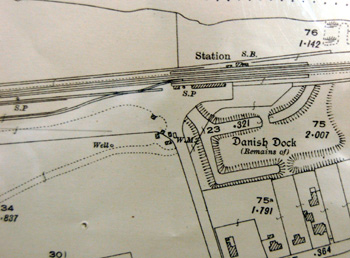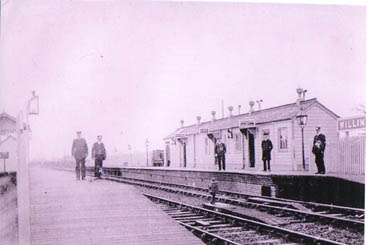Willington Station

Willington Siding on a map of 1901
Willington Station stood on the Oxford to Cambridge line, inside Danish Camp, and was the last station built on that line. Its genesis was a siding built in 1896 to load goods, mainly vegetables. This lay a little distnace to the west of the later station, outside the perimeter of Danish Camp as the maps above and below show. Parishioners had petitioned unsuccessfully for a station when the line first opened in 1862. The railway line was run by the London North Western Railway from its opening in that year
Willington Station finally opened in 1903, the Bedfordshire Times of 1st May that year reported: “WILLINGTON: - the new railway station is about completed, the last thing noticeable being the fixing of the lamps on the platform giving the name of the station. At first, trains will not stop there except when required. Persons wishing to alight must give notice at the preceding station, and when passengers wish to join the train it will be stopped by signal”.

Willington Station on a map of 1926
Two great authorities on Bedfordshire railways were Fred Cockman and Geoff Webb, both now deceased. The two disagreed about the history of Willington station, Fred Cockman maintaining that the station was built entirely of wood and Geoff Webb that the platforms were stone. Bedfordshire and Luton Archives and Records Service Operations Manager Nigel Lutt discovered by chance that both, in fact, were right. The original station was entirely built in wood but a year after completion, in 1904, was burned down as the following article from the Bedfordshire Times of 19th August reveals:
WILLINGTON STATION BURNED DOWN
“After years of agitation by market gardeners and others the London and North-Western Railway Company in May of last year were persuaded to listen to the growing popular demand and provide a fully equipped station at Willington to take the place of the siding which had done duty for some time. The volume of trade had grown remarkably, and the absence of proper accommodation caused considerable difficulty, often fraught with annoyance and loss to those to whom it was of prime importance to get their produce early and promptly to market. The partition and sale of the Duke of Bedford’s farms into market gardening holdings also opened up a new and increasing channel of trade, and it was therefore not surprising that the new facilities, besides meeting a long and keenly felt want, had already proved an excellent thing for the Company. But, alas, in three short hours on Friday night [12th August], the station was destroyed by fire, and nothing but the charred remains of the uprights of the buildings and of the platform, standing like gaunt sentinels over the scene of wreckage and desolation, remained of this monument to the district’s patience and perseverance”.
“The entire structure was of wood, with the exception of the urinals, which for sanitary reasons were of brick. The platform was composed of sleepers and the buildings which were erected on these sleepers, were of pitch-pine. It is estimated that there were well over 200 tons of wood in the portions destroyed. The only theory at present as to the origin of the fire is that a spark from a passing train was blown underneath the platform near the waiting-room, and this space being open would give plenty of draft whereby a spark would be well fanned. At the same time it would be well concealed until the flames had got good hold, as the buildings backed to the road. Indeed so great a hold had the fire got when discovered that nothing whatever could be moved, and all the books, papers etc. the goods in the warehouse, the stationmaster’s uniform, and bicycle, a pair of sculls and a tent, were included in the general destruction. Fortunately, the cash was in a fire-proof safe, and was recovered uninjured. With admirable forethought the Stationmaster despatched messengers with red lamps up the line to stop the two excursion trains from Yarmouth, one at Sandy Station and the other at Blunham, as the flames had made the metals red-hot and burnt the wooden keys which held them in position. Besides, it would have been extremely hazardous to allow the trains to pass through the flames, which were then at their greatest height. The trains were delayed some hours, and it is said, no doubt, with truth, that mine host of Blunham was besieged by the fired-up passengers, and did a roaring trade”.
“There was not much dislocation of business, the accommodation for passenger traffic being resumed with the first train next morning. On Sunday some temporary buildings which had been in use at the Park Royal Show Grounds for the recent Royal Agricultural Show, were brought down from Willesden Junction, and on Monday workmen from Bletchley were busy fitting them up. They include a general waiting room, the stationmaster’s private office and a ticket office, and are placed on a floor of sleepers. We believe it is intended to use this accommodation until a substantial station can be erected, the volume of trade fully justifying this expenditure”.
“The fire was first noticed by a cottager named Collins, who, at about 10.30, as he was going the round of his premises to lock up and see that all was well, before retiring for the night, was attracted by a flare stationwards. He at once acquainted the Stationmaster, Mr. Bywater, but even then the fire had got too firm a hold, and in a few minutes the flames completely enveloped the buildings. Messengers were despatched to Bedford and Sandy Fire Brigades on bicycles, all other communications with the world having been cut off through the destruction of the telephone. Meanwhile the flames leaped higher and higher, and could be plainly seen all along the country side and the Ouse valley at such divergent points as Ravensden, Grafton Works, Bedford and Blunham Stations, and Morhanger [Mogerhanger]. A large crowd gathered, and the Stationmaster quickly organised an efficient bucket service from the river, which at this point flows within 30 yards of the river. 50 villagers eagerly and untiringly participated and their efforts being devoted to the saving of that part of the platform not yet compromised, they managed to confine the fire to the parts already well alight - the buildings and that part of the platform in front of them. But for this timely help, organised as it was by the Stationmaster, the fire would have made a clean sweep, as in the time which elapsed before the Brigades were on the spot the whole must have been destroyed. Something like 150 feet of the platform, with the lamp standards and fencing, was saved”.
“Messengers were despatched at 11.10 for both Brigades, Sandy received their call at 12 o’clock, and arrived on the scene about 12.40. The hose was at once run out to the river, but the manual had to be taken round by road, the half-mile’s journey causing a further loss of time. This being the first fire of any size the Brigade had had since possessing their new steamer, the worthy firemen were not a little chagrined that when a chance had come their way to show what they could do with it, it should be at Messrs. Maythorn’s carriage works, Biggleswade, undergoing repairs to the wheels. Hard luck, Sandy! They had perforce to be content with the manual, which has seen better days, and under the circumstances they could not do more than complete the work so well commenced by the buckets. As to the Bedford Brigade there seems to be something wrong somewhere. The messenger, we are assured, was despatched on cycle to Bedford at 11.10 but the call was not received at the fire station until 12.45, an hour and a half later. The Bedford men answered the call with their accustomed alacrity, and in less than a quarter-of-an-hour were on their way to the scene, arriving there at 1.24 to find the fire practically out. A few of the sleepers constituting the platform were still smouldering, and after a consultation with Captain Mead of Sandy, it was agreed to leave Sandy to finish. The Bedford men stayed a few minutes, and then returned, not having unrolled a piece of hose. Sandy left about 4.45 a. m. the hedge and some vegetation on the other side of the road were badly scorched”.
The new platforms were built in stone.
In 1923 the London and North western Railway Company firm merged to form the London Midland Scottish Railway Company. This became part of the nationalised British Rail in 1948. In the early 1950s Barbara Wooding worked as a porter at Willington Station, leaving in 1958. She then became the first female signalman in the Midland Region, serving at Willington from 1958 to 1960. At a time when careers on the railways were almost entirely taken by men this was a notable achievement.
The Oxford to Cambridge railway line closed on 31st March 1962, as part of the cuts to the national infrastructure laid out by Richard Beeching. Willington Station closed along with the line.
Local historian Dorothy Jamieson notes that the remains of the former station platform can be seen south of the path to Danish Camp Visitors' Centre. The car park was once the railway goods yard and the remains of the weighbridge can still be seen [2010].

Willington Station in 1927